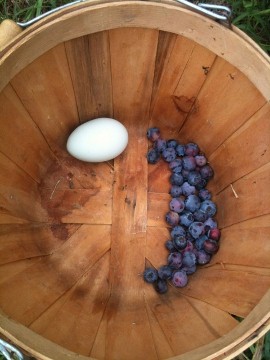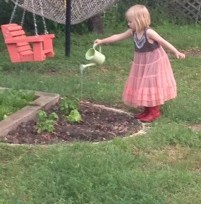It is a pleasure to welcome Katherine Patton as Alt Ed Austin’s newest guest writer. Katherine not only directs and teaches at The Joyful Garden preschool but also is an accomplished urban farmer who conducts Urban Farm Camps for both kids and adults. Here she shares the rationale behind her agricultural work with the very young as well as some tried-and-true tips for parents and others who want to grow things with kids.
The Why

I’ll be honest: I started integrating farming activities into my preschool program because of my own passion for being outdoors and growing things. To me, it has always made sense to structure my work with young children (aged eighteen months to three years) around what interests me most. Being outside, growing and tending plants and animals, and turning the end results (fruits, vegetables, honey, eggs) into delicious food on the table are hobbies that have become integral to my life and livelihood. Sharing them with the children I teach and care for was just a natural for me, in terms of interest (mine and theirs), setting (outdoors), and results (beautiful feasts for the senses; the hands, eyes, ears, nose, and taste buds can all enjoy the process of raising our plants & animals).
It’s only recently, about a year after actively integrating farming activities into our daily routines, that I have researched and weighed all the benefits of doing so. It turns out that farming (or growing and caring, as I think of it) is beneficial for children from the youngest ages, for so many reasons! Gardening and caring for our chickens support early childhood development by:
- providing a setting for active/experiential learning—sensorial work, in the Montessori lexicon
- giving children opportunities to practice social skills, such as verbal communication and cooperation—social/emotional work
- supporting healthy eating and food choices—self-care
- introducing principles of science, such as botany and biology
- reinforcing preliteracy and prenumeracy by providing endless opportunities for naming and counting
All that is wonderful, but to me, it’s all about the daily experiences with the children. No moment is more positive, more filled with potential, than the moment each morning when I push open the farm gate and walk through it with my young charges. Pip the dog runs ahead to check around the chicken pens. The children and I straggle behind, taking in the berry and herb beds, sometimes finding flowers, leaves, and fruit to pick, smell, and taste. A rooster’s crow or the approach of one of the cats, purring and begging to be petted, might stop us in our tracks. One is an occasion to clap our hands over our ears, the other to stop and gently touch soft feline fur.
We eventually reach the shed, from which I can extract the huge chicken feed container and several small sand pails. Children grab scoops and fill the pails with chicken feed. They practice their social skills and conflict resolution, working out who should use which scoop. Fine and gross motor skills are strengthened. Resilience gets a workout when someone is disappointed by the scoop that he or she ends up with. I might count the number of scoops going into the pail. Soon pails are full and scoops go back into the container. Children observe while I dump the feed into the feeders and the chickens chow down.
 When we tire of observing—sometimes quite a while later—we check for eggs. Many times there are some that we can count and carry, sometimes none are waiting for us. Our next stop is the garden, where we check for ripe vegetables for our brunch table. Very often, undersized/underripe fruits and vegetables are picked prematurely. It’s all a part of learning in the garden. Over time, the children learn that tomatoes and berries are not ready until they are richly, darkly colored. The proof is in the tasting! Cucumbers and summer squash can be either too small and hard or too large and seedy. They experience the range over time during our indoor work time, when we wash and slice the garden’s bounty for brunch-time consumption. Sometimes the garden’s offerings make it onto the table; sometimes not.
When we tire of observing—sometimes quite a while later—we check for eggs. Many times there are some that we can count and carry, sometimes none are waiting for us. Our next stop is the garden, where we check for ripe vegetables for our brunch table. Very often, undersized/underripe fruits and vegetables are picked prematurely. It’s all a part of learning in the garden. Over time, the children learn that tomatoes and berries are not ready until they are richly, darkly colored. The proof is in the tasting! Cucumbers and summer squash can be either too small and hard or too large and seedy. They experience the range over time during our indoor work time, when we wash and slice the garden’s bounty for brunch-time consumption. Sometimes the garden’s offerings make it onto the table; sometimes not.
When we sit to eat our mid-morning meal, not every child likes, or will even taste, our harvest. But I know that each exposure to a new food increases the chance that a child will try and enjoy it at some point. If it takes, as some experts say, ten exposures to a new food before a young child will actually taste it (some say fifteen exposures), I know that each child with me that day has seen that food twice—once in the garden, and once at the table. They see me tasting and enjoying it, and with any luck, at least one of their peers will be enjoying it also. In this simple way, we are laying the foundation for healthy eating habits.
The How
Here are a few of my tips for growing and caring with the very young:
Focus on the process, rather than the product. A toddler might focus on scooping soil, to the exclusion of getting to the next steps of planting seeds to sprout, and then watering, and so on. Provide the materials and tools that are capturing the child’s focus right now. You can always seed separate starting trays while he or she is occupied with all that scooping.
Start small. One to three pots filled with dirt alone might be enough for a young child to experience (touch, smell, even taste) as a start. Start some seeds in other pots, set up and out of the way; your kiddo will likely be delighted to help you harvest when they bear fruit.
Keep it safe. Examine the environment for sharp edges, biting insects and spiders, and other hazards before offering it to a young child. Practice organic cultivation rather than using chemical pest deterrents and fertilizers. Research livestock-borne disease risk before allowing your child to interact with animals, and keep a close eye on all child-animal interactions. Chickens and other farmyard animals can frighten or injure a young child through just their natural behaviors (pecking, quickly taking flight, crowing). Teach your child to eat only those plants and fruits that you have approved for consumption. A good mechanism for enforcing this, which has nothing to do with asking permission, is to make a habit of washing everything before tasting. This gives the grownup a chance to review what will be consumed in advance of dining.
Grow plants that are easy and that you like. If you hate tomatoes, don’t grow them! Grow food that you will enjoy sharing with your child. If there is a vegetable that you know she or he loves, plant some seeds. Once your kid enjoys picking that favorite from the garden and eating it, it’s a short stroll to the next pot, where a soon-to-be-favorite is growing.
Katherine Patton



























